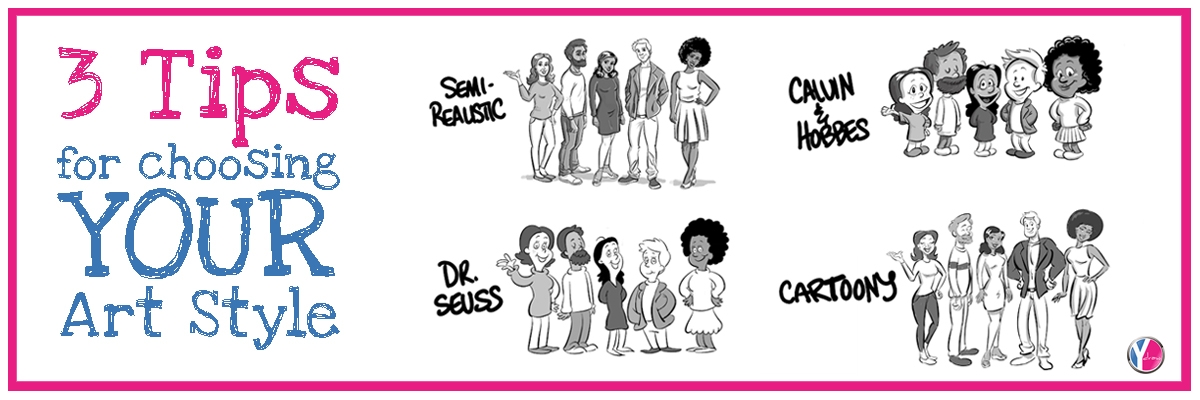
by Ydraw | Sep 5, 2018 | animation, Animation Production, Animation Video, Customer Service, Video Strategy Guide, Ydraw

If you fail to plan, you plan to fail. Take any man-made wonder for example. The Great Pyramids, Eiffel Tower, Empire State Building, Sistine Chapel etc… all of these remarkable accomplishments had to be mentally and visually created before being accomplished. In other words, someone had to think these things up before they were made. I believe any artist, whether they be sketching or preemptively visualizing, goes through a conceptual creative process. The world literally looks the way it does today because of this process being successfully actualized through creators minds over the course of thousands of years.
Not in all cases, but in most, the success of any art form is derived heavily from the conceptual creative process. This is why this process is so critical when trying to create an effective end result, whether that be constructing a building or styling someone’s hair. Whenever I start a new visual project, I like to do several things. First I like to sit down and brainstorm ideas, often times with the client. This helps me gain a better understanding of what needs to be included in the final product. Sometimes clients aren’t sure what they want so be prepared with visual ideas and be sure to ask lots of questions. Second I like to add fuel to the “creative fire” by gathering and absorbing materials that inspire me. For example, listening to music and gathering ideas from other types of media. Everyone is inspired by different things so this may be different for everyone. And third, I usually create a rough storyboard containing visuals and descriptions of what I plan to create.
These three things are in no way an exhaustive list, every creator is different. However, at Ydraw we have found this process to work really well for our videos. As you start the creative process you may discover that some steps work better for you than others so make sure to experiment and find what works best for you. However you may decide to carry out your own conceptual creative process, do it! By taking the time to plan out your next creation beforehand, you will increase the effectiveness of the final product.
Written by Brenden Nelson -Ydraw Video Animator
by Jace Vernon | Jun 13, 2018 | animated doodle videos, animated explainer video, Animated Whiteboard Videos, Animation Video, Art Style, Customer Service, How to pick a video style, How to pick an art style, quick draw video, scribble video, Training Videos, Whiteboard animation, Whiteboard Video

Everyone wants a viral video. In fact, that’s what most of our clients ask for when they come to us. But, when it’s time to look at our Art Styles page – many clients panic and think,
“What if I choose the wrong one?”
That’s why we are going to talk about the difference that art choice can make to your video and a few things to think about when choosing yours. Because although we pride ourselves on working with the most talented artists in the industry – that doesn’t mean that every one of them is the best choice for your project.
Let me tell you a short story.
Once upon a time, a client named Booz Allen came to us for their first whiteboard animation video. They are a serious, respected firm with very serious, important clients. Even though this video was internal, they wanted it to be serious, professional, and aspirational.
But, there was just one thing.
Their Scriptwriter had a gut instinct – what if we juxtaposed the informational tone of the script with a fun, unexpected art style like Calvin & Hobbes to create a surprise effect?
Well, Booz Allen decided to go with Semi-Realistic instead. Here’s the first scene from the first set of images delivered by their choice of artist:

This works. It gets the job done. However, Booz Allen isn’t in the business of just getting the job done. So, they made the command decision to switch artists (for a small fee).
Here’s the first scene again – with the exact same script – rendered in the Calvin & Hobbes style:

Now THAT’s memorable!
Just using a different art style brings the script to life in a completely new way.
In fact, this style was such a huge hit –they have made dozens of videos since in this style.
This is a perfect example of how the right art style can truly elevate a project.
So, what should you consider when choosing the art style for your project?
Here are 3 things to consider:
- TONE/MOOD:
What is the tone of your script – what feelings does the voiceover evoke? And, what do you want the mood to be of your video? Some examples might by light-hearted and humorous. Other scripts are heavy, covering more serious subject matter. Or, maybe you just want an approachable, informational tone. For example, this video we made for Volunteers of America was designed to be beautiful, moving and inspiring. Using our YPaint style, the images are digitally revealed and we incorporated an animated fine line connecting them to support this vision:
- ELEMENT OF SURPRISE:
Now, just because your tone and mood are serious – doesn’t mean your art style has to be! By using an unexpected pairing, you create the element of surprise! Examples of this could be the Booz Allen video – which pairs a fun, youthful art style with serious internal subject matter. Or, take a look at this video for the marketing company, Ribyt. They used color to create an element of surprise, by staying all B&W except for their brands green.
Another way to create an element of surprise is to use a mixed-media approach, by combining different types of video footage. In this case, Vital Smarts used a mixture of live video and whiteboard animation:
- AUDIENCE:
Sometimes the right art style is the one that will appeal most to your audience.
Ask yourself, “What would my target consumer want to see?”
After all, you’re making this video for them, right?
That’s exactly what our client, Wilson Electronics, had in mind when we created this short, one-scene video in our Cartoony style to capture the feeling that people have when they realize their cell phone signal hasn’t been working:
BOTTOM LINE:
Be willing to think outside the box when choosing an artist!
The right art style will pair perfectly with your script and grab the attention of your audience.
We love working with our clients to discuss options, send samples, and help guide you to choosing the perfect art style for your project.

by Jace Vernon | Jun 18, 2013 | Creative Marketing, Customer Service, Marketing, Video Marketing, video online marketing, website design
Understanding Your Audience | 3 things to remember when getting to know your consumers.
Getting the most out of your video marketing campaign can be as simple as understanding your audience. Maybe it doesn’t actually sound so simple – and here’s the thing – it’s not. If you want to broaden your marketing horizons you must use social media. Social media has become so much more than just glorified chat rooms and photo boards. Sites like Facebook have become a community in and of itself where people interact, make new friends, create their own awareness campaigns, and much more. And even if you’re on board with social media for your business, creating a website, Facebook, and Twitter pages will not ensure that people will come to you. You need to act and interact, post often and respond to your follower’s questions and comments. Get your business out there! Developing a solid marketing strategy to use with social media will allow you to reap the maximum benefits from your efforts.
But to do that you have to know a few things: Who exactly are you trying to reach? Who is your target audience? What appeals to them? Trying to understand who your audience is can be daunting, but here are a few key ways to get to know the people who will be buying your product:
1. Research
This is perhaps the most important and direct way to get to know your audience. Input gathered from real live people can help to design your marketing campaigns to be the most effective. A few ways to gather information from your audience includes:
– Conduct surveys and/or take polls throughout your current following to find out what they like, don’t like, how they watch online video, what they feel they would add, and what is important to them. Asking questions is the easiest and sometimes most efficient way to interact with your visitors.
– Using web analytics is another popular way for businesses to see what kinds of people are visiting their site. Google Analytics is the preferred analytical tool – easy set up and completely free!
– There are sites such as Rapleaf that makes sure everyone using the internet has a great experience. To use these sites, a business sends a list of all user emails. The site then searches its database for those specific email addresses and provides you with information about the person using that email address, such as age, gender and location.
2. Know the Social Media Types
There are three distinct categories of consumers who spend their time online. First, there is the silent majority. These are the observers, they don’t usually post often, share often, or respond often. It may seem fruitless to chase after this group, but they are the largest group and are always watching. Second is the vocal minority. These are the people who share posts, videos, links, etc… They are always commenting on things others have shared and are anxiously interacting with others. These are the consumers who will spread the word about your business to their silent majority friends. Cater to them. The third and smallest group is the social authorities. These are the trailblazers – the ones with great online influence who have successful blogs or sites of their own. If you can get in good with these guys, you’re about set.
3. Ask Questions
Conducting surveys is an excellent way to gather information, but if you really want to go deep, you need to do a little digging yourself. There are three specific questions you should always ask when trying to get to know your audience:
– What are the customer’s preferences for content?
– How do they discover, consume and share content?
– What do they talk about on social media sites?
Once you have in mind who your target audience is, there are a few things you should do to keep them coming back. These include tailoring your future marketing campaigns to appeal to them. Make sure the aesthetics of your site, images and videos appeal to them. For example, if your business is trying to appeal to an older generation, use mostly muted colors, a clean design, conservative graphics and a classic font. If you’re marketing toward teens or young adults, use eye-catching graphics, creative design features and bold, popping colors.
Remember, social media and your audience’s behavior is always changing. Stay on top of any changes by pursuing an active role across all the social media platforms. Be a part of the action; listen to what your audience wants. Do what you can to make sure your business will never be left behind.
* * * * *
See a related post HERE.
+Jessica Anderson





